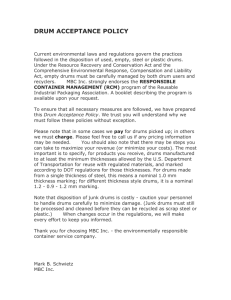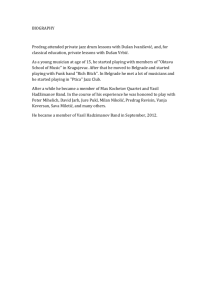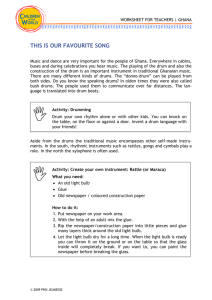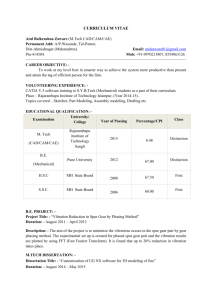Sample-Mid-term - Rose
advertisement
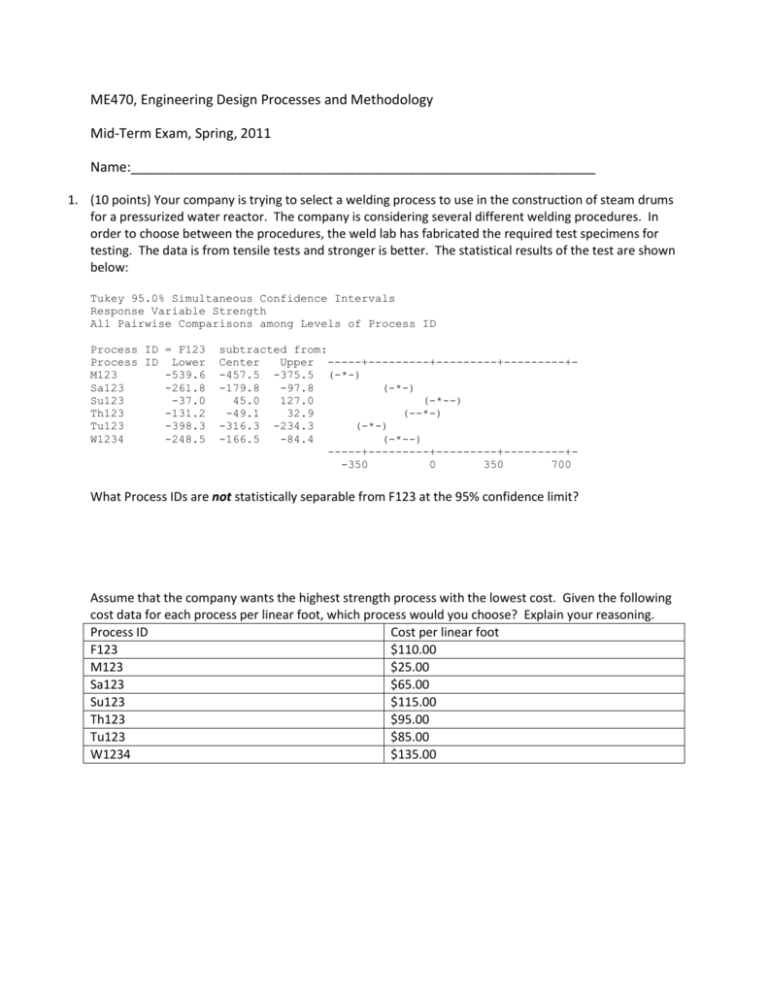
ME470, Engineering Design Processes and Methodology Mid-Term Exam, Spring, 2011 Name:______________________________________________________________ 1. (10 points) Your company is trying to select a welding process to use in the construction of steam drums for a pressurized water reactor. The company is considering several different welding procedures. In order to choose between the procedures, the weld lab has fabricated the required test specimens for testing. The data is from tensile tests and stronger is better. The statistical results of the test are shown below: Tukey 95.0% Simultaneous Confidence Intervals Response Variable Strength All Pairwise Comparisons among Levels of Process ID Process ID = F123 Process ID Lower M123 -539.6 Sa123 -261.8 Su123 -37.0 Th123 -131.2 Tu123 -398.3 W1234 -248.5 subtracted from: Center Upper -----+---------+---------+---------+-457.5 -375.5 (-*-) -179.8 -97.8 (-*-) 45.0 127.0 (-*--) -49.1 32.9 (--*-) -316.3 -234.3 (-*-) -166.5 -84.4 (-*--) -----+---------+---------+---------+-350 0 350 700 What Process IDs are not statistically separable from F123 at the 95% confidence limit? Assume that the company wants the highest strength process with the lowest cost. Given the following cost data for each process per linear foot, which process would you choose? Explain your reasoning. Process ID Cost per linear foot F123 $110.00 M123 $25.00 Sa123 $65.00 Su123 $115.00 Th123 $95.00 Tu123 $85.00 W1234 $135.00 2. (30 points) Parts manufactured in an injection molding process are showing excessive shrinkage. This is causing problems in assembly operations downstream from the injection molding area. A quality improvement team has decided to use a designed experiment to study the injection molding process so that shrinkage can be reduced. The team decided to investigate six factors – mold temperature, screw speed, holding time, cycle time, gate size and holding pressure – each at two levels with the objective of learning how each factor affects shrinkage and also, something about how the factors interact. The team decides the use the 16-run, two-level fractional factorial design shown below. Run 1 2 3 4 5 6 7 8 9 10 11 12 13 14 15 16 MoldTemp ScrewSpeed HoldTime CycleTime -1 1 -1 1 -1 1 -1 1 -1 1 -1 1 -1 1 -1 1 -1 -1 1 1 -1 -1 1 1 -1 -1 1 1 -1 -1 1 1 -1 -1 -1 -1 1 1 1 1 -1 -1 -1 -1 1 1 1 1 -1 -1 -1 -1 -1 -1 -1 -1 1 1 1 1 1 1 1 1 GateSize -1 1 1 -1 1 -1 -1 1 -1 1 1 -1 1 -1 -1 1 HoldPress -1 -1 1 1 1 1 -1 -1 1 1 -1 -1 -1 -1 1 1 Shrinkage 6 10 32 60 4 15 26 60 8 12 34 60 16 5 37 52 The observed shrinkage (x10) is shown for the test part produced at each of the 16 runs in the designs. A fractional factorial is analyzed the same as a full factorial. In order to test your understanding of the meaning of the statistical analysis, a Pareto Chart, a mean effects plot, and an interaction plot are included. Study each of these plots and make suggestions concerning the proper levels for each of the parameters so that the shrinkage can be minimized. You must justify each of your parameter settings with information from the plots. You should not do any analysis in Minitab. Everything that you need is provided. Pareto Chart of the Effects (response is ObservedShrinkage, Alpha = 0.05) 2.41 F actor A B C D E F B Term A AB AD ABF AE AC D C AF N ame M oldTemp S crew S peed H oldTime C y cleTime G ateS ize H oldP ress E F BF BD BEF 0 10 20 Effect 30 40 Lenth's PSE = 0.9375 Main Effects Plot (data means) for ObservedShrinkage MoldTemp 50 ScrewSpeed HoldTime Mean of ObservedShrinkage 40 30 20 10 -1 1 -1 Cy cleTime 50 1 -1 GateSize 1 HoldPress 40 30 20 10 -1 1 -1 1 -1 1 Interaction Plot (data means) for ObservedShrinkage -1 1 -1 1 -1 1 60 40 MoldTemp MoldTemp -1 1 20 60 40 ScrewSpeed ScrewSpeed -1 1 20 60 40 HoldTime 20 CycleTime Which factors are significant at a 95% confidence limit? Which interactions are significant at a 95% confidence limit? After analyzing the graphs, complete the table below: Parameter Mold Temp. Screw Speed Holding Time Cycle Time Gate Size Holding Pressure Suggested Setting Reason HoldTime -1 1 http://commons.wikimedia.org/wiki/File:Gear_pump_exploded.png http://www.britannica.com/EBchecked/topic-art/227609/7032/External-gear-pump 3. (15 points) Consider the gear pump shown above (with more schematic functional drawing above right). The drive shaft turns the drive gear which causes the idler gear to also turn. Oil enters the suction port or inlet and exits the pressure port or outlet (at a higher pressure). a) Create a Subtract and Operate table for two items, the Idler Gear and the Seal. b) State one function (in verb noun form) for the idler gear c) State one function (in verb-noun form) for the seal d) For the System that is the gear pump, sketch and label all the inputs and outputs (indicating Material, Energy, and Signal) Gear Pump 4. Does the following “need statement” comply with the guidelines in the textbook? If yes, explain why it complies. If no, explain how it is not in compliance. Customer Statement: I hate it when my backpack bounces when I run. Need Statement: An adjustable sternum strap should be added to the backpack. 5. Write a “need statement” for the following customer statement. Customer Statement: When I’m canoeing and my hands are wet, I can’t keep hold of my backpack zipper. Need Statement: 6. For the following “need statement”, assign a metric (name the units and describe what you will measure. Need Statement: The backpack protects a laptop. Units: What is measured? 7. You have met the standard for “competence” to undertake a public works engineering project only if a) You hold an appropriate professional engineering license in that discipline. b) The project outcome will protect the safety, health and welfare of the public. c) You hold a degree in that engineering discipline d) You follow appropriate codes and specifications 8. You are the chief engineer for Boiler Drum Company and have specialized in the design and construction of high pressure steam drums. As a result, you were invited to join the industry’s Boiler and Drum Design Code committee. With the advent of higher pressure steam plants, the industry saw a need to revise the Boiler and Drum Code to accommodate the new, high pressure units and you have been working as a member of the committee for about 2 years revising the code. Due to increased knowledge of the high temperature strength behavior of new steel alloys, the new code will allow high pressure steam drums to have thinner walls than under the previous code. Your company, Boiler Drum Company, is preparing a bid for several of these new steam drums for a new power plant. With your knowledge of the revised code, you could bid the drum less expensively than before. Your proper behavior is: A. Design and cost the drums using the old code. B. Design and cost the drums using the expected new code without appropriate references or clearly stating the design bias. C. Design and cost the drums using the expected new code but indicate that the design is based on the proposed code. Explain your reasoning for your selection. 9. In 2005, a senior design group looked at reducing radiator noise for an undisclosed company. In order to reduce the noise, they looked at four factors: A: B: C: D: Fins/in (Low is 7, and High is 11) Number of rows of fins (Low is 4 and High is 8) Fin Design (Dimple or Louver) (Low is Louver and High is Dimple) Air Velocity (miles/hour) (Low is 40 and High is 58) The output measured is sound pressure in Pa, and the goal is to minimize the pressure. The final model obtained by the team is shown below: Estimated Effects and Coefficients for actual number (coded units) Term Constant Fins/in Number of rows Fin design Air Velocity Fins/in*Number of rows Fins/in*Air Velocity Number of rows*Air Velocity Effect -15433 12056 -2796 19756 -8507 -14878 12465 Coef 10379 -7717 6028 -1398 9878 -4253 -7439 6232 SE Coef 787.0 787.0 787.0 787.0 787.0 787.0 787.0 787.0 T 13.19 -9.80 7.66 -1.78 12.55 -5.40 -9.45 7.92 P 0.000 0.000 0.000 0.119 0.000 0.001 0.000 0.000 Write an equation for the sound pressure in Pa using the model developed by the team. Evaluate the model when Fins/in is 9, Number of rows of fins is 6, fin design is dimple, and air velocity is 49 miles/hour.




